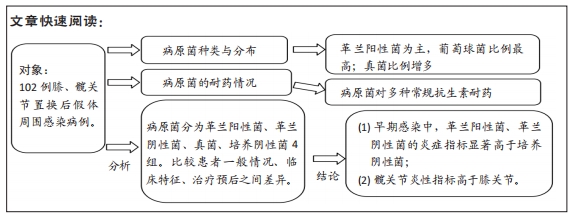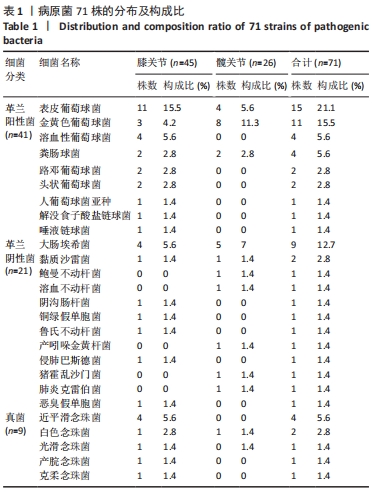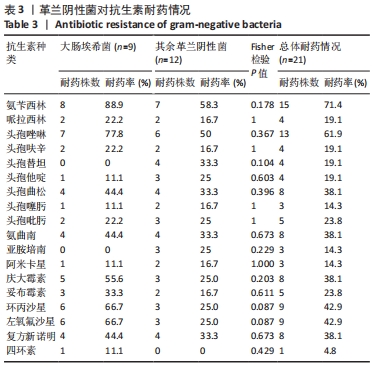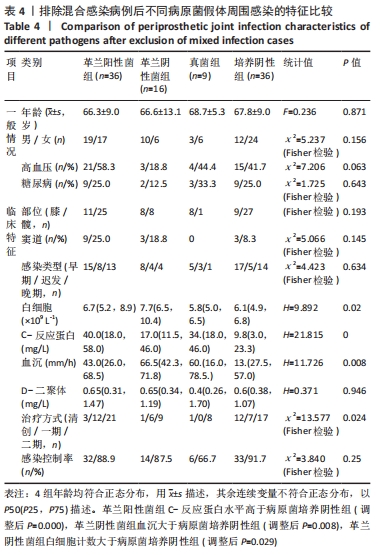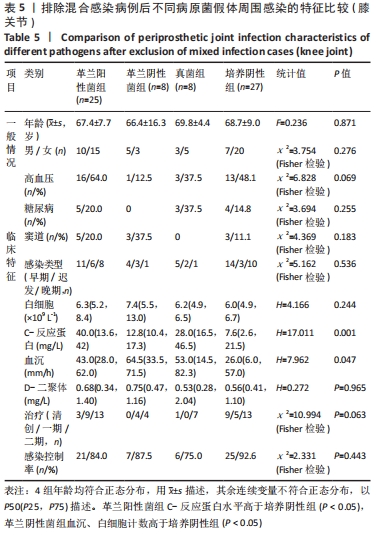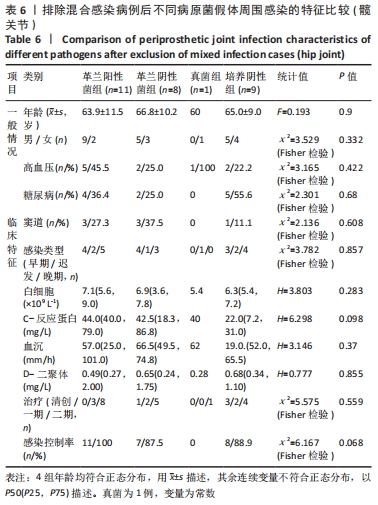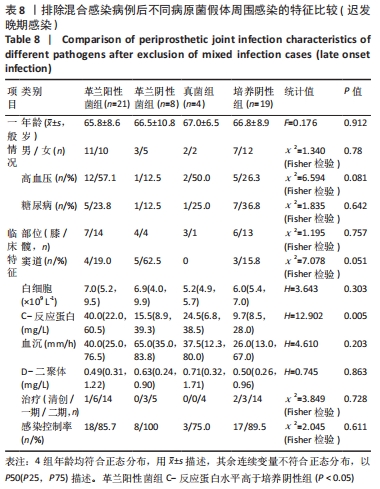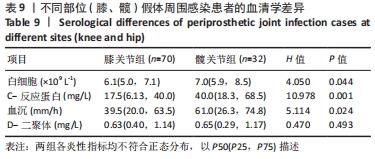[1] 边焱焱,程开源,常晓,等.2011至2019年中国人工髋膝关节置换手术量的初步统计与分析[J].中华骨科杂志,2020,40(21):1453-1460.
[2] KURTZ SM, ONG KL, LAU E, et al. Prosthetic joint infection risk after TKA in the Medicare population. Clin Orthop Relat R. 2010;468(1):52-56.
[3] DALE H, HALLAN G, HALLAN G, et al. Increasing risk of revision due to deep infection after hip arthroplasty. Acta Orthop. 2009;80(6):639-645.
[4] BAEK SH. Identification and preoperative optimization of risk factors to prevent periprosthetic joint infection. World J Orthop. 2014;5(3):362-367.
[5] BEAM E, OSMON D. Prosthetic Joint Infection Update. Infect Dis Clin N Am. 2018; 32(4):843-859.
[6] LI ZL, HOU YF, ZHANG BQ, et al. Identifying Common Pathogens in Periprosthetic Joint Infection and Testing Drug-resistance Rate for Different Antibiotics: A Prospective, Single Center Study in Beijing. Orthop Surg. 2018;10(3): 235-240.
[7] 周一逸,刘仪,袁鹏,等.骨关节置换术后假体周围感染的病原菌特征及影响因素分析[J].中华医院感染学杂志,2019,29(14):2189-2193.
[8] CHOI HR, KWON YM, FREIBERG AA, et al. Periprosthetic joint infection with negative culture results: clinical characteristics and treatment outcome. J Arthroplasty. 2013;28(6):899-903.
[9] PARVIZI J, GEHRKE T, CHEN AF. Proceedings of the International Consensus on Periprosthetic Joint Infection. Bone Joint J. 2013;95-B(11):1450-1452.
[10] KAPADIA BH, BERG RA, DALEY JA, et al. Periprosthetic joint infection. Lancet (London, England). 2016;387(10016):386-394.
[11] MORAN E, MASTERS S, BERENDT AR, et al. Guiding empirical antibiotic therapy in orthopaedics: The microbiology of prosthetic joint infection managed by debridement, irrigation and prosthesis retention. J Infect. 2007;55(1):1-7.
[12] KALBIAN I, PARK JW, GOSWAMI K, et al. Culture-negative periprosthetic joint infection: prevalence, aetiology, evaluation, recommendations, and treatment. Int Orthop. 2020;44(7):1255-1261.
[13] LIU H, ZHANG Y, LI L, et al. The application of sonication in diagnosis of periprosthetic joint infection. Eur J Clin Microbiol Infect Dis. 2017;36(1):1-9.
[14] 于洋,张少坤,陆世涛,等.宏基因组二代测序技术在假体周围感染病原诊断中的应用[J].中华骨科杂志,2021,41(5):280-288.
[15] 崔苛苛,杨伟毅,刘军,等.全膝关节置换后假体周围感染病原菌分布特点及治疗策略[J].中国组织工程研究,2017,21(35):5721-5726.
[16] 程翔,梁玉龙,邵宏翊,等.假体周围感染病原菌及耐药性分析[J].中国矫形外科杂志,2020,28(11):870-875.
[17] TSAI Y, CHANG CH, LIN YC, et al. Different microbiological profiles between hip and knee prosthetic joint infections. J Orthop Surg (Hong Kong). 2019;27(2): 2309499019847768.
[18] BROWN TS, PETIS SM, OSMON DR, et al. Periprosthetic Joint Infection With Fungal Pathogens. J Arthroplasty. 2018;33(8):2605-2612.
[19] ESCOLÀ-VERGÉ L, RODRÍGUEZ-PARDO D, LORA-TAMAYO J, et al. Candida periprosthetic joint infection: A rare and difficult-to-treat infection. J Infect. 2018; 77(2):151-157.
[20] TÓTH R, NOSEK J, MORA-MONTES HM, et al. Candida parapsilosis: from Genes to the Bedside. Clin Microbiol Rev. 2019;32(2):e00111-00118.
[21] 王加利,张燕,蔺伟,等.人工关节置换术后假体感染的病原学分析[J].中华医院感染学杂志,2014, 24(9):2251-2253.
[22] 赵欣宇,陈廖斌,谭杨,等.利福平在人工关节假体周围感染治疗中的应用[J].中华骨科杂志,2016,36(19):1263-1267.
[23] NISCHAL PM. First global report on antimicrobial resistance released by the WHO. Natl Med J India. 2014;27(4):241.
[24] WIJESEKARA PNK, KUMBUKGOLLA WW, JAYAWEERA JAAS, et al. Review on Usage of Vancomycin in Livestock and Humans: Maintaining Its Efficacy, Prevention of Resistance and Alternative Therapy. Vet Sci. 2017;4(1):6.
[25] KHEIR MM, TAN TL, SHOHAT N, et al. Routine Diagnostic Tests for Periprosthetic Joint Infection Demonstrate a High False-Negative Rate and Are Influenced by the Infecting Organism. J Bone Joint Surg Am. 2018;100(23):2057-2065.
[26] PARVIZI J, DELLA VALLE CJ. AAOS Clinical Practice Guideline: diagnosis and treatment of periprosthetic joint infections of the hip and knee. J Am Acad Orthop Surg. 2010;18(12):771-772.
[27] HARTMAN MB, FEHRING TK, JORDAN L, et al. Periprosthetic knee sepsis. The role of irrigation and debridement. Clin Orthop Relat Res. 1991;(273):113-118.
[28] BEROZ F, YAN J, SABASS B, et al. Verticalization of bacterial biofilms. Nat Phys. 2018;14(9):954-960.
[29] BERBARI EF, MARCULESCU C, SIA I, et al. Culture-negative prosthetic joint infection. Clin Infect Dis. 2007;45(9):1113-1119.
[30] NACE J, SIDDIQI A, TALMO CT, et al. Diagnosis and Management of Fungal Periprosthetic Joint Infections. J Am Acad Orthop Surg. 2019;27(18):e804-e818.
[31] MCARTHUR BA, ABDEL MP, TAUNTON MJ, et al. Seronegative infections in hip and knee arthroplasty: periprosthetic infections with normal erythrocyte sedimentation rate and C-reactive protein level. Bone Joint J. 2015;97-B(7):939-944.
[32] 何金,袁雪凌,陈歌.细菌培养结果对髋假体周围感染翻修结果的影响[J].中国矫形外科杂志,2020,28(23):2127-2130.
[33] LEE YS, LEE YK, HAN SB, et al. Natural progress of D-dimer following total joint arthroplasty: a baseline for the diagnosis of the early postoperative infection. J Orthop Surg Res. 2018;13(1):36.
[34] HU Q, FU Y, TANG L. Serum D-dimer as a diagnostic index of PJI and retrospective analysis of etiology in patients with PJI. Clin Chim Acta. 2020;506:67-71.
|
